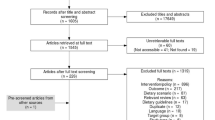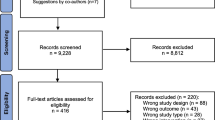Abstract
Food is an important determinant of health, featuring prominently in the Sustainable Development Goals. The term “big data” is seldom used in relation to food, partly because food data are scattered across different sectors. The increasing availability of food-related data presents an opportunity to glean new insights on food and food systems. These insights may enhance the quality of products and services and improve decision-making on optimizing food availability, all to the end of producing better health. Yet, knowledge gaps remain about the unique opportunities and challenges linked to big data on food and their use in decision-making. This scoping review explored the available literature linking food with big data and decision-making, using the following research question: What is the current literature on data about food, and how are these data used in decision-making? We searched PubMed until 29 February 2020 and Embase, Web of Sciences, and the Cochrane Database of Systematic Reviews until 8 March 2020. We included studies written in English and conducted narrative analyses to identify relevant themes from included studies. Sixteen studies fulfilled our eligibility criteria, including big data analyses, modelling studies, and reviews. These studies described the added value of using big data and how evidence from big data had or can be used for decision-making, as well as challenges and opportunities for such use. The majority of the included studies examined the link between food and big data, while hypothesizing of how these insights could inform decision-making, including policies, interventions, programs, and financing. There were only two examples wherein big data on food informed decision-making directly. The review highlights several false dichotomies in how the subject is approached in the literature and the importance of context, both between and within countries, in shaping the availability and types of data that can be used as meaningful evidence to inform decision-making. This review shows the paucity of research around the intersection of food, big data, and decision-making, as well as the potential in using big data on food systems to the end of informing decisions to improve the health of populations. Future research and decision-making around health systems can benefit from examining the full spectrum of perspectives on the subject. Future research and decision-making around health systems can also employ the steadfast embrace of technology, which will potentially reduce disparities in big data availability, to the end of improving the health of populations.

Similar content being viewed by others
References
Dubé L, Labban A, Moubarac J-C, Heslop G, Ma Y, Paquet C. A nutrition/health mindset on commercial Big Data and drivers of food demand in modern and traditional systems: roadmap paper on metrics and analytics. Ann N Y Acad Sci. 2014;1331(1):278–95. https://doi.org/10.1111/nyas.12595.
Gómez MI, Ricketts KD. Food value chain transformations in developing countries: selected hypotheses on nutritional implications. Food Policy. 2013;42:139–50. https://doi.org/10.1016/j.foodpol.2013.06.010.
Dubé L, Pingali P, Webb P. Paths of convergence for agriculture, health, and wealth. Proc Natl Acad Sci. 2012;109(31):12294–301. https://doi.org/10.1073/pnas.0912951109.
Sjauw-Koen-Fa A. Framework for an Inclusive Food Strategy. Utrecht (In The Netherlands): Rabobank; 2012.
Kraak VI, Story M. A public health perspective on healthy lifestyles and public–private partnerships for global childhood obesity prevention. J Am Diet Assoc. 2010;110(2):192–200. https://doi.org/10.1016/j.jada.2009.10.036.
Slining M, Yoon E, Davis J, Hollingsworth B, Miles D, Ng S. Complexities of Monitoring Food and Nutrition from Factory to Fork: the University of North Carolina at Chapel Hill Crosswalk Approach. Chapel Hill, NC: University of North Carolina; 2013.
Thomas B, Gostin LO. Tackling the global NCD crisis: innovations in law and governance. J Law Med Ethics. 2013;41(1):16–27. https://doi.org/10.1111/jlme.12002.
Willett W, Rockström J, Loken B, Springmann M, Lang T, Vermeulen S, et al. Food in the Anthropocene: the EAT–Lancet Commission on healthy diets from sustainable food systems. Lancet. 2019;393(10170):447–92. https://doi.org/10.1016/S0140-6736(18)31788-4.
United Nations (UN). Sustainable Development Goals. United Nations. Accessed Dec 7, 2020. https://sdgs.un.org/goals
Acemoglu D, Robinson JA. Why Nations Fail: the Origins of Power, Prosperity, and Poverty. 1. ed. New York, NY: Crown Business; 2012.
Moodie R, Stuckler D, Monteiro C, Sheron N, Neal B, Thamarangsi T, et al. Profits and pandemics: prevention of harmful effects of tobacco, alcohol, and ultra-processed food and drink industries. Lancet. 2013;381(9867):670–9. https://doi.org/10.1016/S0140-6736(12)62089-3.
Swinburn BA, Sacks G, Hall KD, McPherson K, Finegood DT, Moodie ML, et al. The global obesity pandemic: shaped by global drivers and local environments. Lancet. 2011;378(9793):804–14. https://doi.org/10.1016/S0140-6736(11)60813-1.
Population Reference Bureau. 2013 World Population Data Sheet. Population Reference Bureau. Published 2013. Accessed December 8, 2020. https://www.prb.org/2013-world-population-data-sheet/
Gartner Information technology glossary. Big Data. Gartner. Accessed Dec 7, 2020. https://www.gartner.com/en/information-technology/glossary/big-data
Marvin HJP, Janssen EM, Bouzembrak Y, Hendriksen PJM, Staats M. Big data in food safety: an overview. Crit Rev Food Sci Nutr. 2017;57(11):2286–95. https://doi.org/10.1080/10408398.2016.1257481.
Tricco AC, Lillie E, Zarin W, O'Brien KK, Colquhoun H, Levac D, et al. PRISMA extension for scoping reviews (PRISMA-ScR): checklist and explanation. Ann Intern Med. 2018;169(7):467–73. https://doi.org/10.7326/M18-0850.
Ouzzani M, Hammady H, Fedorowicz Z, Elmagarmid A. Rayyan—a web and mobile app for systematic reviews. Syst Rev. 2016;5(1):210. https://doi.org/10.1186/s13643-016-0384-4.
Arksey H, O’Malley L. Scoping studies: towards a methodological framework. Int J Soc Res Methodol. 2005;8(1):19–32. https://doi.org/10.1080/1364557032000119616.
Bakhtin P, Khabirova E, Kuzminov I, Thurner T. The future of food production – a text-mining approach. Tech Anal Strat Manag. Published online. 2019;32:1–13. https://doi.org/10.1080/09537325.2019.1674802.
Bogaardt M-J, Geelen A, Zimmermann K, Finglas P, Raats MM, Mikkelsen BE, et al. Designing a research infrastructure on dietary intake and its determinants. Nutr Bull. 2018;43(3):301–9. https://doi.org/10.1111/nbu.12342.
Coble KH, Mishra AK, Ferrell S, Griffin T. Big data in agriculture: a challenge for the future. Appl Econ Perspect Policy. 2018;40(1):79–96. https://doi.org/10.1093/aepp/ppx056.
Drewnowski A, Kawachi I. Diets and health: how food decisions are shaped by biology, economics, geography, and social interactions. Big Data. 2015;3(3):193–7. https://doi.org/10.1089/big.2015.0014.
Dwivedi P, Huang D, Yu W, Nguyen Q. Predicting geographical variation in health-related quality of life. Prev Med. 2019;126:105742. https://doi.org/10.1016/j.ypmed.2019.05.030.
Frelat R, Lopez-Ridaura S, Giller KE, Herrero M, Douxchamps S, Djurfeldt AA, et al. Drivers of household food availability in sub-Saharan Africa based on big data from small farms. Proc Natl Acad Sci. 2016;113(2):458–63. https://doi.org/10.1073/pnas.1518384112.
Global Burden of Disease (GBD). 2015 Eastern Mediterranean Region Collaborators. Danger ahead: the burden of diseases, injuries, and risk factors in the Eastern Mediterranean Region, 1990–2015. Int J Public Health. 2018;63(S1):11–23. https://doi.org/10.1007/s00038-017-1017-y.
Grummon AH, Taillie LS. Nutritional profile of Supplemental Nutrition Assistance Program household food and beverage purchases. Am J Clin Nutr. 2017;105(6):1433–42. https://doi.org/10.3945/ajcn.116.147173.
Jo HS, Jung SM. Evaluation of food labeling policy in Korea: analyzing the Community Health Survey 2014–2017. J Korean Med Sci. 2019;34(32):e211. https://doi.org/10.3346/jkms.2019.34.e211.
Johnson MO, Cozart T, Isokpehi RD. Harnessing knowledge for improving access to fruits and vegetables at farmers markets: interactive data visualization to inform food security programs and policy. Health Promot Pract. 2019;21:152483991987717–400. https://doi.org/10.1177/1524839919877172.
Källestål C, Blandón EZ, Peña R, Peréz W, Contreras M, Persson LÅ, et al. Assessing the multiple dimensions of poverty. Data mining approaches to the 2004–14 Health and Demographic Surveillance System in Cuatro Santos, Nicaragua. Front. Public Health. 2020;7:409. https://doi.org/10.3389/fpubh.2019.00409.
Ng SW, Slining MM, Popkin BM. The Healthy Weight Commitment Foundation pledge: calories sold from U.S. consumer packaged goods, 2007-2012. Am J Prev Med. 2014;47(4):508–19. https://doi.org/10.1016/j.amepre.2014.05.029.
Pokhriyal N, Jacques DC. Combining disparate data sources for improved poverty prediction and mapping. Proc Natl Acad Sci. 2017;114(46):E9783–92. https://doi.org/10.1073/pnas.1700319114.
Protopop I, Shanoyan A. Big data and smallholder farmers: big data applications in the agri-food supply chain in developing countries. Int Food Agribus Manag Rev. 2016;19:173–90. https://doi.org/10.22004/AG.ECON.240705.
World Bank Group. Agriculture and Climate Risk Enterprise – Kilimo Salama – Kenya, Rwanda, Tanzania. World Bank Group; 2016. Accessed December 6, 2020. http://documents1.worldbank.org/curated/en/858031490693709582/pdf/113740-BRI-PartnerProfiles-ACRE-PUBLIC.pdf
van Rijmenam M. How big data can help the developing world beat poverty. DATAFLOQ. Published 2013. Accessed December 7, 2020. https://datafloq.com/read/big-data-developing-world-beat-poverty/168
The Global Information Technology Report 2015: ICTs for Inclusive Growth. World Economic Forum/INSEAD; 2015. Accessed Dec 8, 2020. https://reports.weforum.org/global-information-technology-report-2015/
Tortora B. Africa continues going mobile. Gallup. Published 2014. Accessed Dec 8, 2020. https://news.gallup.com/poll/168797/africa-continues-going-mobile.aspx
United Nations Conference on Trade and Development. Information Economy Report: the Cloud Economy and Developing Countries. United Nations; 2013. Accessed Dec 8, 2020. http://unctad.org/en/PublicationsLibrary/ier2013_en.pdf
International Telecommunication Union (ITU). Measuring the Information Society Report 2018.; 2018. Accessed Dec 7, 2020. https://www.itu.int/dms_pub/itu-d/opb/ind/D-IND-ICTOI-2018-SUM-PDF-E.pdf
Naef E, Muelbert P, Raza S, Frederick R, Kendall J, Gupta N. Using Mobile Data for Development. Cartesian, Inc./ Bill and Melinda Gates Foundation; 2014. Accessed Dec 8, 2020. https://docs.gatesfoundation.org/Documents/Using%20Mobile%20Data%20for%20Development.pdf
Acknowledgments
We thank Leona Ofei for her support in formatting this paper. The Rockefeller Foundation–Boston University 3‐D Commission (Grant number: 2019 HTH 024).
Author information
Authors and Affiliations
Corresponding author
Additional information
Publisher’s Note
Springer Nature remains neutral with regard to jurisdictional claims in published maps and institutional affiliations.
Supplementary Information
ESM 1
(DOCX 16 kb)
Rights and permissions
About this article
Cite this article
Biermann, O., Koya, S.F., Corkish, C. et al. Food, Big Data, and Decision-making: a Scoping Review—the 3-D Commission. J Urban Health 98 (Suppl 1), 69–78 (2021). https://doi.org/10.1007/s11524-021-00562-x
Accepted:
Published:
Issue Date:
DOI: https://doi.org/10.1007/s11524-021-00562-x




